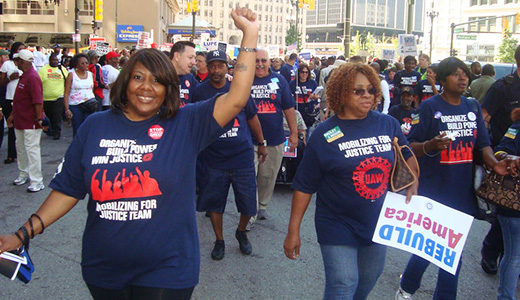
It wasn’t long ago that a criticism directed at trade unions was they were only in it to service their members on a limited number of issues in exchange for dues. The fight of workers for a better workplace was not linked to organizing those workers to fight for a better world for all.
The argument had some merit, but the happenings in Wisconsin over the past two months blew all of that criticism – and that thinking – to shreds. Construction workers joined with teachers. Government workers joined with students. All joined with the people of faith, environmentalists, LGBT activists, peace activists and more to form a diverse coalition that declared, “We are Wisconsin.” And the “we” were demanding a state that represented all, not the wealthy few at the top or those fortunate enough to be members of a union.
This emphasis on fighting for all and fighting on a range of issues affecting all working people, including racism and all forms of discrimination, the environment, peace, education and other matters, is called “social movement unionism.”
That vision came from the Communists, socialists and other activists who built the U.S. labor movement. Somewhere along the line that outlook was lost.
At the bargaining convention of the United Auto Workers last week, the union’s president, Bob King, noted that in the 1930s, ’40s and ’50s people thought the “UAW cared about and fought for everybody.”
He continued, “The struggles in Wisconsin, Ohio, Indiana, and Michigan and throughout the country give us the opportunity to show we’re not just fighting for ourselves, we’re fighting for every worker in America.”
Fighting for every worker has never been so important because globalization changed the rules of the game on how organizing is done. With the same companies producing the same goods throughout the globe, workers no longer can fight battles on their own. King says the pensions, wages and benefits his members deserve are going to continue to erode unless the power of the American labor movement is rebuilt and global solidarity becomes the norm.
While social movement unionism is reappearing in the UAW, problems and challenges remain. For example, the union has negotiated contracts with two-tier wages that pay different rates to workers doing the same job.
But solving these problems requires leveling the now very unequal playing field between unions and companies by building a broad social justice movement, unionizing non-union plants and building worldwide labor solidarity.
The success of social movement unionism begins with power built from and resting with the membership. That is exactly what we are seeing in Wisconsin and elsewhere, with union membership and leadership not only building a revitalized labor movement, but joining with others to build a new nation.
That point was driven home by actor and activist Danny Glover at last week’s UAW convention. He told delegates, “The economic paradigm has failed us. We need a new vision of humanity. Whatever we call it, it is being built by workers in Wisconsin and Indiana.”
When Glover finished, delegates rose to their feet in loud applause. They were ready to build a new social movement.
Photo: Jobs, justice, peace – Aug. 28, 2010: UAW members march in downtown Detroit. International Union, UAW via Facebook












Comments